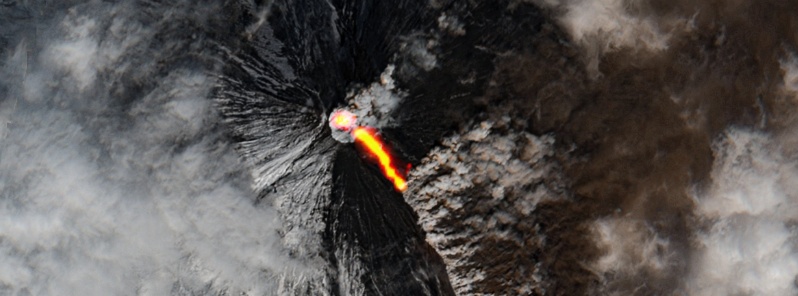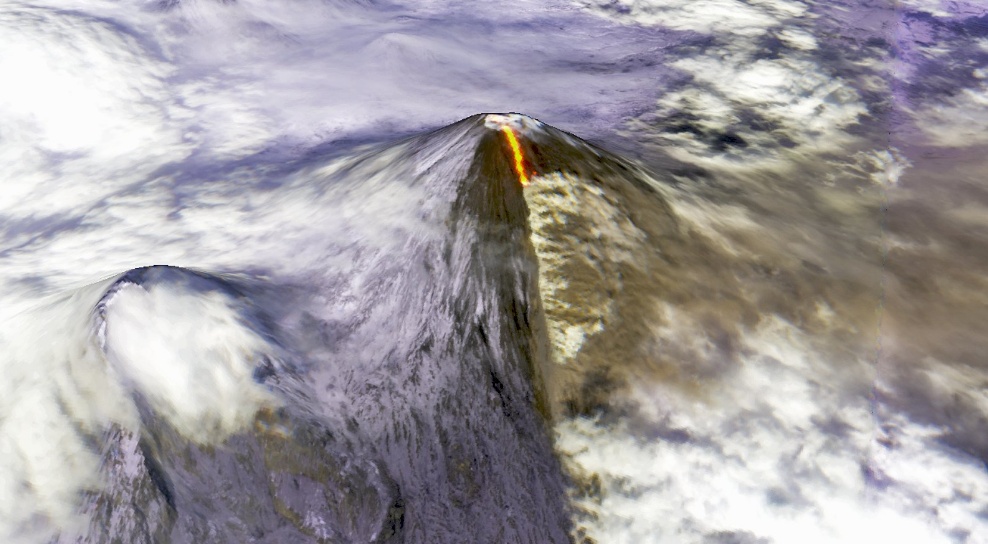Lava flows on the southeastern flank of Klyuchevskoy volcano, Russia

A moderate explosive eruption of the Strombolian and sometimes Vulcanian types continues at Russian Klyuchevskoy volcano. The Aviation Color Code remains Orange.
On April 18, a lava flow began to move on the southeastern flank of the volcano.
By 22:10 UTC, a gas-steam plume containing some amount of ash was extending about 100 km (62 miles) to the NE of the volcano. It was rising up to 5.5 km (23 000 feet) above sea level.





On April 19, European Sentinel-2 satellite captured the following image:


Image credit: Copernicus EU/Sentinel-2. Acquired April 19, 2020. Processed by Pierre Markuse


3D view of the volcano on April 19, 2020. Credit: Copernicus EU/Sentinel-2, Antonio Vecoli, Adam Platform


According to satellite data received early April 20, a gas-steam plume containing some amount of ash was extending about 265 km (164 miles) SE of the volcano.
Ash explosions up to 5 – 7 km (16 400 – 23 000 feet) a.s.l. could occur at any time, KVERT warned, adding that ongoing activity could affect low-flying aircraft.
Geological summary
Klyuchevskoy (also spelled Kliuchevskoi) is Kamchatka's highest and most active volcano. Since its origin about 6 000 years ago, the beautifully symmetrical, 4 835-m-high (15 862 feet) basaltic stratovolcano has produced frequent moderate-volume explosive and effusive eruptions without major periods of inactivity. It rises above a saddle NE of sharp-peaked Kamen volcano and lies SE of the broad Ushkovsky massif.
More than 100 flank eruptions have occurred during the past roughly 3 000 years, with most lateral craters and cones occurring along radial fissures between the unconfined NE-to-SE flanks of the conical volcano between 500 m and 3 600 m (1 640 – 11 811 feet) elevation.
The morphology of the 700-m-wide (2 296 feet) summit crater has been frequently modified by historical eruptions, which have been recorded since the late-17th century. Historical eruptions have originated primarily from the summit crater, but have also included numerous major explosive and effusive eruptions from flank craters. (GVP)
Featured image credit: Copernicus EU/Sentinel-2. Acquired April 19, 2020. Processed by Pierre Markuse

Commenting rules and guidelines
We value the thoughts and opinions of our readers and welcome healthy discussions on our website. In order to maintain a respectful and positive community, we ask that all commenters follow these rules:
We reserve the right to remove any comments that violate these rules. By commenting on our website, you agree to abide by these guidelines. Thank you for helping to create a positive and welcoming environment for all.